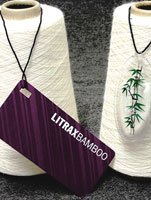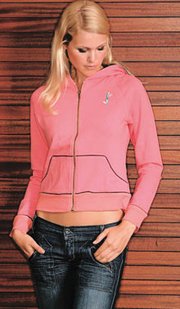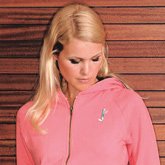Attendance Up and Business Returns at Spring
Swiss company Litrax looks to put the ’green’ back in bamboo.
Felix Stutz has no illusions about the nature of traditional bamboo.
“Years ago, we said: ’This is not right. You’re labeling something natural which is not natural. It is filled with chemicals,’” he said.
But get Stutz talking about the sustainability of bamboo, and he can—in his words—talk for hours.
“The benefit of bamboo is that it grows faster than 99.9 percent of any other plant,” he said. “It can be harvested several times a year. It doesn’t need any water conditioning like cotton does. It grows with virtually no care at all. It’s a wild grass, and it grows like grass. As a matter of fact, it grows like crazy. If you want to make your neighbor crazy, put some bamboo in your garden.”
Stutz is the chief executive officer of Swiss company Litrax GmbH, which has developed a new “greener” method of processing bamboo and plants into fiber. The company was founded in 2005 to create sustainable raw materials for a wide range of industries, from textiles and construction to cosmetics and bio-plastics.
“We’re trying to do crazy things with raw materials that are sustainable or natural or semi-natural,” Stutz said. “When I say semi-natural, [I mean] polyester is not really natural, but when you take a recycled polyester chip, it’s sort of a more environmentally friendly approach.”
In its textile division, Litrax is currently focused on recycled polyester containing natural additives and several variations of natural bamboo fibers and composites. But the company is also looking into other sustainable textiles made from fibers such as banana or nettle plants. Litrax has new bamboo and functional filament/fiber developments made with pyrolized bamboo or mineral additives that can warm or cool the skin quickly, according to Stutz, who said the company is working on a double-faced performance fabric that can be reversed for cooling in summer and warming in winter. The company is also working with a large denim brand to produce a prototype jean made from a blend of natural bamboo and silk denim. And Stutz said he hopes to introduce a bamboo blend with a closed-loop viscose in January.
Since its founding, Litrax has made inroads in the European apparel market. To open up the U.S. market, Litrax recently named apparel-industry consultant Valerie Cooper to its executive committee. Cooper is a Los Angeles native whose Fayetteville, Ark.–based company, Heart Hunters Consulting, has operations in Arkansas, Los Angeles and South Florida. Cooper, who continues to run her consulting business, has been working with Litrax on an ongoing project for the past two years. Cooper first learned about Litrax while researching fabrics for one of her clients, a Finnish yogawear manufacturer. “I affectionately call her ’granola people,’” Cooper said. “She wanted something that was clean.”
Cooper’s client wasn’t initially interested in bamboo because of the chemicals used to process the fiber. But she said her client was interested in Litrax’s process, which Cooper dubbed “green chemistry.” FTC takes on bamboo
Fabrics made from bamboo are touted as having a soft, luxurious hand and the eco imprimatur of being made from a rapidly renewable resource. But bamboo’s detractors argue that the chemical processes used to turn the bamboo plant into a fiber that can be spun into yarn are harsh, pollute the environment and essentially produce rayon.
In August, the Federal Trade Commission joined the debate, issuing an alert titled “How to Avoid Bamboozling Your Customers,” which warns companies against inaccurately labeling fabrics as 100 percent bamboo. According to the FTC, most fabrics made from bamboo are, in reality, rayon, which is made “using environmentally toxic chemicals in a process that emits hazardous pollutants into the air.” The FTC further warned that “while different plants, including bamboo, can be used as a source material to create rayon, there’s no trace of the original plant in the finished rayon product.”
Only fabrics made “directly with bamboo fiber”—typically called “mechanically processed bamboo”—can be labeled as bamboo, the FTC said, adding that manufacturers must be prepared to show scientific evidence and analysis that the material is, in fact, made from bamboo.
The government agency subsequently charged four companies with “bamboozling” their customers by selling products incorrectly labeled as made from 100 percent bamboo. All four companies—Los Angeles–based Pure Bamboo; Nashville, Tenn.–based Mad Mod; Pittsburgh-based Jonano; and Andrews, S.C.–based Bamboosa—eventually settled with the FTC, agreeing to no longer market their products as being made from bamboo without adequate documentation to prove that claim.
For many eco manufacturers, the FTC ruling eliminated bamboo from the list of acceptably green fabrics.
“We have not used it at all, specifically because of the bad environmental impact during processing,” said Samantha Robinson, who co-designs Raw Earth Wild Sky with Karen Kananen. The Los Angeles–based contemporary label, founded in 2006, is made with organic and eco-friendly materials—but not bamboo.
“We noticed a lot of companies jumped on the wagon a few years ago because it was something new and touted it as being a new eco-fabric revolution,” Robinson said. “Sadly, the only thing eco is that bamboo is a renewable/sustainable resource—the processing to get the beautiful silky hand and drape in fabrics is extremely intensive since bamboo is such a tough/hard plant.”
Litrax is hoping to change that perception with its new natural bamboo fiber, which is processed using enzymes.
Litrax always labeled its previous viscose bamboo products as “viscose,” in accordance with French and German labeling laws, but with the introduction of the new enzymatic natural bamboo fiber, the company is hoping to get an interim standard for its bamboo-making process, which Stutz describes as “much, much, much more environmentally friendly” than traditional viscose. Litrax’s bamboo yarns are currently certified tested for harmful substances by the Oeko-Tex Standard 100.
Stutz said he agrees with the FTC decision. “It was absolutely great news on one end,” he said. “On the other end, it’s a headache because now we need to apply for us to get recognition as a true natural bamboo fiber supplier.”
The processing of Litrax’s bamboo is “really a cocktail of things—mechanical, chemical and enzymatic,” Stutz said.
In order to turn bamboo into a fiber, the plant must be crushed and treated with chemicals to break down the bamboo’s structure and eliminate some of the pectin and lignin. Unlike traditional bamboo processing, Litrax’s method does not dissolve the bamboo down to the cellulosic material. The crushed bamboo strands are treated with enzymes to separate the fibrous material from the glue-like lignin within the plant. The final step is to bleach the fibers with hydrogen peroxide.
“We need some chemicals but a fraction of the chemicals used in the viscose process—let’s say less than 10 percent,” Stutz said. “What really does the job are the enzymes.”Best when blended
Most of Litrax’s bamboo textiles fall into two categories: a performance “thermobamboo” and a fashion “natural bamboo” fiber. The company recommends using its bamboo in blends, in part to keep the cost down and in part to mitigate the rough hand of the natural bamboo.
“Bamboo has a feel which is similar to linen or hemp,” Stutz said. “We recommend it to be blended with Supima, normal cotton, merino or silk.”
Litrax’s natural bamboo, L1, is best blended with a long staple fiber, according to Cooper, who added: “What’s absolutely gorgeous is L1 with merino wool. Imagine it for a jersey that goes on a cross-country cyclist in the Italian Alps.”Vertically minded
Cooper describes Litrax as “a vertical production solution for the whole [apparel] industry for the supply chain.”
“They supply fiber to the spinners, yarn to the mills,” she said.
Stutz qualifies that description a bit, calling Litrax a “vertical-thinking” company.
“We want to be a vertical-thinking operation, but we want to be located at the bottom,” he said. “We like raw materials.”
Litrax has partners to help with each stage in the production process—“from the nano powders or the spinning of the fibers to making yarns, making fabrics or making garments,” according to Stutz.
“We welcome any vertical level to contact us, whether it’s spinning factories or fabric makers—anybody who wants to team with us,” he said. “We’re really trying to do a lot of things, crazy things, for any kind of industry.”





























